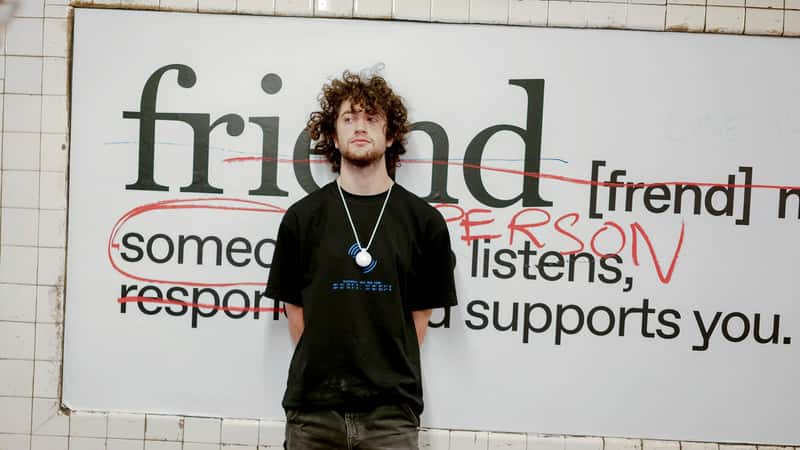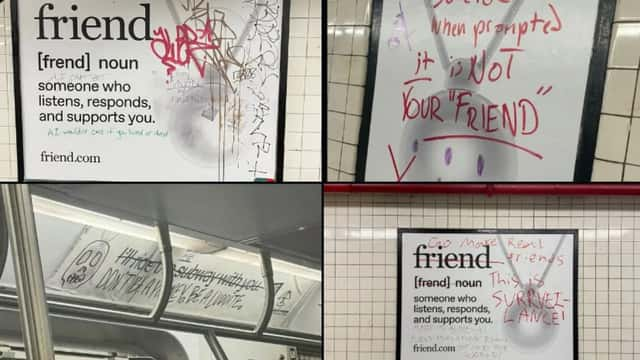NYC hates AI: Lessons from 2025’s most disastrous OOH campaign
We unpack Friend’s $1M NYC subway AI OOH fail and Claude Café’s success. Plus: A playbook for AI OOH marketing that earns trust with every audience.

TL;DR: AI-companion startup Friend spent roughly $1M flooding the NYC subway with 10k+ stark-white posters and faced a Sharpie-fueled backlash. Weeks later, Anthropic poured coffee in the West Village, answered privacy questions, and let New Yorkers try Claude in person. Same city, two opposite results — read on for your playbook on how (and how not) to take AI OOH.
Why the Friend AI OOH campaign bombed
Friend, a 2025 AI-companion startup, sells a $129 microphone-on-a-necklace that pairs with your phone to chat and log moments. In late summer this year, it mounted a seven-figure subway takeover — 10,000+ white posters across 11,000 subway cars, plus more on platforms and street furniture, built around tender one-liners like “I’ll binge the entire series with you”.
The campaign achieved ubiquity. But not affection. Within days, New Yorkers were defacing ads with warnings about surveillance and snark about “getting real friends.” Local coverage and social feeds turned the campaign into a Rorschach test for AI anxiety.
When comprehension is low and the product touches an already sensitive topic, context and consent matter more than clever copy. Friend’s NYC OOH never demonstrated value or privacy guardrails in the creative. It didn’t even explain the product. So New York did, as New York does and supplied its own story: intrusive tech trying to replace human connection. Friend’s founder didn’t back off, describing the reaction as “entertaining,” which only hardened the narrative that provocation was the point.

© afaqs!
What the Friend campaign could have done differently
Imagine the same media budget aimed at in-situ DOOH showing the product in action. A 12-second loop on a concourse board: someone heading to a first date asks for help picking a venue; the assistant suggests a spot, offers conversation starters, and surfaces a safety reminder—with visible privacy controls on screen.
A QR code scan recreates the exact flow on your phone in under a minute. Then, instead of a subway takeover, seed small, staffed kiosks where passersby can try one task and leave with a complete understanding of the product, instead of leaving this to imaginations already influenced by dystopian AI narratives. In a city allergic to hype, utility travels.
AI OOH Done Right: Anthropic’s pop-up Claude Café
A few weeks later, in the West Village, Anthropic turned the Air Mail newsstand into a week-long Claude Café. People lined up, grabbed coffee and “thinking” caps, asked about privacy and control, and — crucially — tried the AI product.
Anthropic reported 5,000+ visitors and ~10M social impressions. The human centric experience framed AI as something that works with you, not instead of you, — and it didn’t fight New York’s AI skepticism, it answered it with proof.
 © Anthropic
© Anthropic
Takeaways for AI brands going OOH
- Know who you’re talking to. Provocation without education is a bad idea. Friend went for ubiquity; the city pushed back in permanent marker.
- Demonstrate the product. A poorly established brand without proof invites projection. If you tell but don’t show—people will imagine the worst. (This is doubly true for wearables that listen.)
- Controversy is for the brave — and the prepared. Provocation works only when people already grasp the value you’re defending. Friend seemed to anticipate blowback but didn’t offer a counter-narrative beyond the provocation itself.
Bottom line: People aren’t anti-AI; they’re pro-human. So for OOH marketers, it’s important to treat the format for what it is: a trust medium. Lead with consent, clarity, and demonstration. And never skip the human step, or a city like New York will quickly remind you what you’ve forgotten, in permanent marker.



